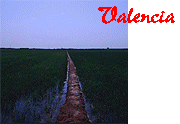Andalucia
and
the Ebro delta (just to the north of Valencia in Tarragona) together
produce 50% of Spain's rice, but Valencia (producing a further 18%) has
become closely associated with rice dishes made from the short grain
arborio
rice grown in Spain. The most famous being Paella (pie-ay-ah), which
has
two styles, Valencian being a different type, without a sofrito.
Note that it is considered impolite to arrive late for a paella and
when
a waiter brings the plates for the main course its probably time to
finish
the starters quickly. When the paella is ready - it is ready!
![]()
Paella
Mixta 1
Soften
one
Spanish onion and a few cloves of garlic in olive oil in a wide
pan, add four skinned plum tomatoes and cook down to a sofrito. Add
some
pieces of chopped chicken2, as well as a few saffron
threads.
When the chicken is cooked add a cup of arborio rice and some water.
When
rice is almost soft add a variety of seafood in time to be cooked when
the rice is ready. Prawns, clams, squid and mussels make a good choice.
Take the pan to the table decorated with lemon wedges and some
"specimen"
seafood such as crayfish or large prawns you have cooked in the oil
before
starting the paella.
"Valencia"
paella
is meat not fish based, see below
Many
purists do not believe in mixing seafood and meat, so you may want to
leave
this out, even though it is common in Spain and may have originated in
the wish of non christians to be seen to be eating "christian" food at
the time of the Inquisition.
Do
not keep stirring a paella like rissotto. It should be crisp not
creamy. The "socarrao" or crispness of the finished dish is important.
Calasparra rice is ideal.
Arroz Negro
Arroz
a
banda
Rice
and
sofrito
flavoured with the pan juices and fish frames and shells from fish and
seafood used in other dishes. Some authorities claim it is served with
the actual fish and seafood in a separate bowl. I ordered it in a
locals
bar in the middle of the Valencian rice paddies and it came just as the
rice. Perhaps the home cook or expensive restaurant would serve with
the
seafood. Anyway, my "take" on this dish is to fry the rice and garlic,
along with a little chopped tomato and onion, then add fish/seafood
stock
of good quality, flavoured with saffron, simmer for about 20 minutes
until
the stock is absorbed.
Paella
Valenciana
Meat
and
beans replace the seafood of the marisco version (it is worth
remembering
that paella may contain almost anything).
There
is
no sofrito in this version, just tomatoes.
Beans,
both
green (french beans) and white (garrofó)
with rabbit or chicken and possibly snails; rosemary, saffron and sweet
paprika (pimenton dulce).
José
Martínez's authentic recipe
My
version of "Fideua" (for two) using any seafood and fish pieces to
hand.
(Clams, prawns and pieces of monkfish would be fine)
Make
a rich fish stock from fish frames and seafood shells. Strain, reduce
and
add saffron.
Roast
three red peppers (30 minutes) until soft, skin and slice, discarding
seeds.
Fry
fresh prawns and pieces of boned fish in olive oil, set aside.
Make
and boil one portion of thin pasta like spaghetti, strain and cut into
short lengths.
Cook
any bivalves in the stock, add the fish and seafood with the oil along
with any precooked seafood and the peppers, add the pasta and then
thicken
with a picada made from pounding garlic and parsley. Serve.
Jambalaya
The
Louisiana dish Jambalaya is almost certainly a descendant of Paella
made
with local ingredients. The source of the name is less certain:-
It
may be Jamon- Paella (ham- paella) or it may come from the French
"jambon".
One
source suggests it is Jamb(on), the African[1] word "ya", meaning rice,
with the Acadian [Cajan] "a la" in between. But this seems to assume
that
the current spelling can be relied on, (an 1880s recipe refers to
"jumberlie"
and spelling was certainly "jumbalaia" before the current one).
Jumbalaya
replaces the sofrito with a saute of celery, onion and (bell) pepper,
"chaurice"
sausage takes the place of "chorizo", ham, possibly chicken, cayenne
and
paprika are added along with lots of tomato. The rice when added is
softened
with chicken stock, the dish being finished with prawns. Like Paella,
it
is a very variable dish.
[1]
no specific language quoted
See
also
:-
Cheese
Wine
Spanish
cookery books
Cookery
reference books
Walking
in Spain
Walking
in Britain
Spanish
photos
Spanish
pronouciation & general guidebooks
Andalucia
Asturias
Basque
Country
Canary Islands Castile
Catalonia
& Balearics Extremadura
Galicia
ValenciaTapas
Glossary
Books
